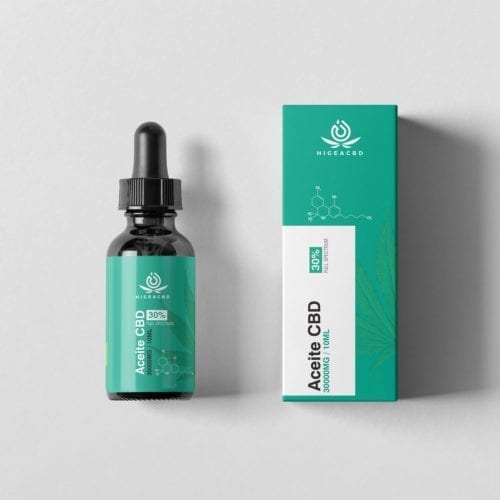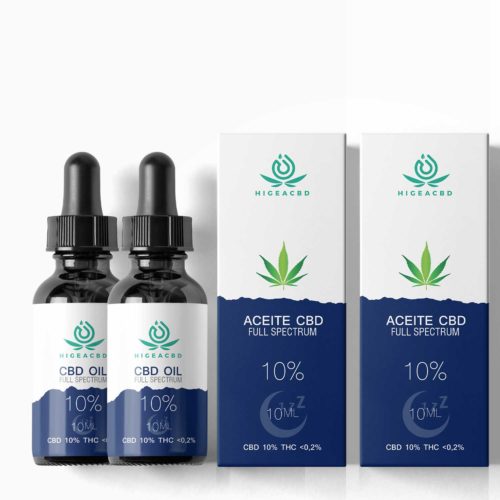Endocannabinoid system
In 1988, during a subsidized by the U.S. government of the St. Louis. Louis University School of MedicineAllyn Howlett and William Devane determined that the mammalian brain has certain cannabinoid receptors (CB1R) that react to compounds found in cannabis plants. In fact, these receptors are the type of neurotransmitters that most abounds in the brain.
This scientific discovery boosted investment in research into the potential of cannabis. In 1990, a scientific team led by Lisa Matsuda managed to map the DNA sequence of one of these cannabinoid receptors in the brain. The experiments were carried out on genetically modified mice lacking the G-protein-coupled receptor: Indeed, the cannabidiol THC administered to these mice had no effect, proving that THC activates cannabinoid receptors in the brain. During this same study another cannabinoid receptor was identified which was bautized as CB2R and is present in different tissues throughout our body predominating in the immune system and nervous system.
Having already identified several cannabinoid receptors CB1R and CB2R, everything indicated that in every mammal there is a complex network of cannabinoid receptors that react with endocannabinoids produced naturally in our organism. This is the endocannabinoid system and it is located not only in the nervous system and the brain but also there is scientific evidence that mammals have cannabinoid receptors in other organic tissues such as the liver and pancreas.
In this article we will talk about the cannabinoid receptor and also about the endocannabinoid system. In fact, the ECS is considered to be a complex cell signaling system, which was discovered in the early 1990’s by scientists researching THC.
As we know, THC is a well-known cannabinoid, as it is a compound found in cannabis. It is important to note that researchers are still trying to fully understand the endocannabinoid system as well as the cannabinoid receptors, including the cb1 receptor. What is known to date is that it plays a fundamental role in the regulation of a wide range of functions and processes in our bodies, including:
- State of mind
- Reproduction and fertility
- The quality of sleep
- Appetite
- Memory
It is interesting to mention that the endocannabinoid system (ECS) exists, and is active in our body, even without the need to use cannabis. Below we tell you a little more about this system, and the function of the receivers.
Showing 1–8 of 25 results
-
Sale!
Aceite Higea CBD 10%
29,95€ Add to cart -
Sale!
Hygea CBD Oil 20%.
49,90€ Add to cart -
Hygea CBD oil 30%.
89,95€ Add to cart -
Sale!
Aceite Higea CBD 5%
19,95€ Add to cart -
Higea CBD muscle pain cream 50 ml
21,95€ Add to cart -
Basic Pack
47,41€ Add to cart -
Medium pack
94,81€ Add to cart -
Sale!
Healing Balm Hygea CBD
19,95€ Add to cart
It has been 30 years since these discoveries and there are still many questions to be solved regarding the endocannabinoid system. On the one hand, legislation in force over the past few decades has stigmatized cannabis due to its psychotropic effects and as a result has slowed investment in related scientific studies. However, on the other hand, empirical applications and experiments in recent years have managed to break down these barriers so that science can decipher why such positive effects are described when consuming certain cannabinoids. The cannabis derivatives market is booming and is expected to move up to $22 billion in the coming years.
Cannabionoid receptors have been found in the genus Hydra,a very primitive organism, so scientists sense that the endocannabinoid system is more than 500 million years old in the history of evolution.
How does the endocannabinoid system (ECS) work? Endocannabinoid receptors
The endocannabinoid system is made up of three central components, which are: endocannabinoids, cannabinoid receptors, and enzymes. Let’s see in detail what each of these components consists of.
Endocannabinoids
Endocannabinoids are also known as endogenous cannabinoids. These are basically molecules that are produced by our body, and are very similar to the cannabinoids found in cannabis. To date, researchers have been able to identify two key endocannabinoids, which are:
- Anandamide (AEA)
- 2-arachidonoylglycerol (2-AG)
Both molecules aim to contribute to maintaining the internal functions of our bodies without conflict. An important thing to note is that our body produces endocannabinoids as it needs them. Because of this, it is often very difficult to determine what the typical levels of each molecule are.
Endocannabinoid receptors
These receptors are also produced by our body. In fact, they are found throughout our bodies. The function of the receptors is to bind with the endocannabinoids to signal the endocannabinoid system to act. In this case, two main cannabinoid receptors have been identified:
- The first of these is the cb1 receptor, which can be found particularly in the central nervous system of our organism.
- The second is the cb2 receptor, which in this case is located mainly in the peripheral nervous system of our body, more specifically in the immune cells.
Here it is worth noting that endocannabinoids can bind to either of these two cannabinoid receptors. However, the resulting effects depend on where the receptor is located, as well as the type of endocannabinoid it binds to.
In other words, endocannabinoids can bind to cb1 cannabinoid receptors on a spinal nerve, with the goal of providing pain relief. It is also possible that other endocannabinoids can bind to cb2 cannabinoid receptors on your immune cells to indicate that the body is experiencing inflammation.
Enzymes
As for enzymes, they are organic molecules responsible for breaking down endocannabinoids, once they have carried out their function. Within the endocannabinoid system there are mainly two types of enzymes that are responsible for this task:
- The enzyme fatty acid amide hydrolase, which breaks down anandamide (AEA).
- The enzyme monoacylglycerol acid lipase, which in this case breaks down 2-arachidonoylglycerol (2-AG).
Inverse agonist and inverse antagonist
The agonist is a drug that has the ability to mimic the effects of endogenous neurotransmitters. The inverse agonist, on the other hand, is also a drug, but in this case it produces the opposite action to the agonist. That is, it produces effects opposite to those of a neurotransmitter.
It should also be said that antagonists are those who are responsible for blocking the effects of agonists, and inverse agonists.

The endocannabinoid system broadly
All humans and mammals have an endocannabinoid system. It is a web of receptors and neurotransmitters that regulates physiological reactions in response to our environment and is present in different organs of our body, but above all in our brain and through our nervous system. Broadly speaking, we could say that the endocannabinoid system is responsible for making all systems work harmoniously in our body to maintain homeostasis. It is a neurotransmission system that is composed of endocannabinoids, enzymes that help synthesize them, and the cannabinoid receptors with which they connect and activate.
What are endocannabinoids?
They are the cannabinoids that your body is able to produce and act as neuromodulators presynaptically to synthesize or release a neurotransmitter into the synaptic cleft.
So far two endocannabinoids have been identified:
- Anandamide (AEA): is a neurotransmitter derived from an essential fatty acid omega 6. Just as glutamate, adrenaline or dopamine arachydonoylethanolamide (AEA) goes through the nervous system and gets neurons to communicate with each other. Its name comes from the Sanskrit “ananda” which means happiness and peace because it is responsible for relaxing and reassuring. It can be found in some foods such as cocoa and in some fish, sea urchins and roe.
- 2-araquidonilglycerol (2-AG)
Although these two endocannabinoids have currently only been determined, the probability of the list growing is very high as science advances in the field. Endocannabinoids are made of membrane phospholipids,most of them are the combination of a fatty acid with an amine so natural combinations are immense since in our body there are many different types of fatty acids and amines present.
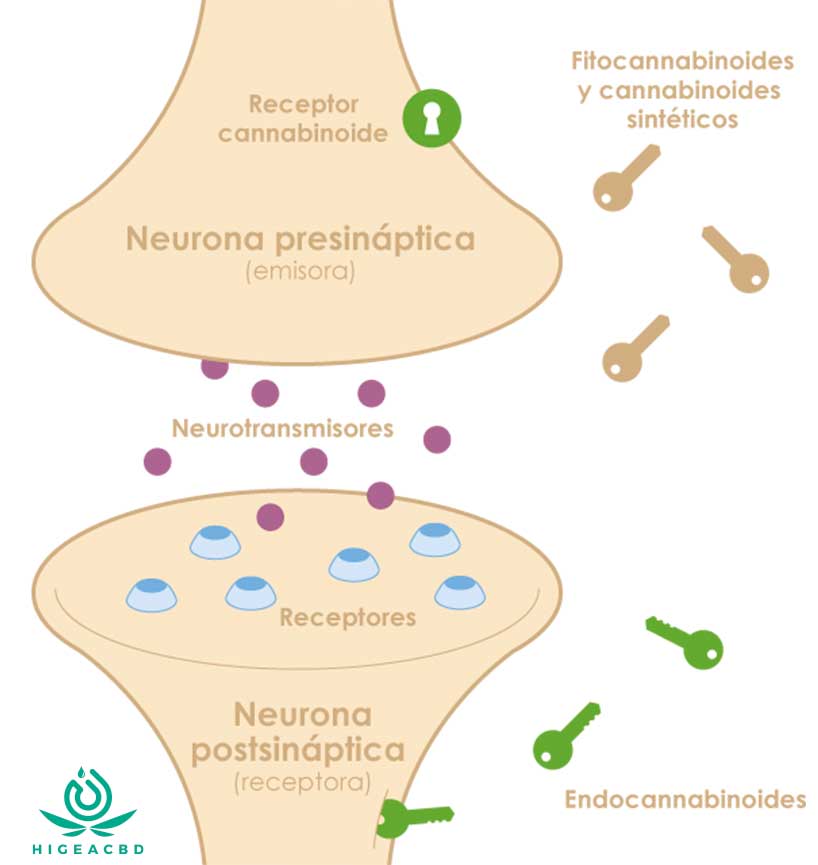
What are cannabinoid receptors?
They are spread throughout our organism and endocannabinoids transmit signals for the Endocannabinoid System to take action.
So far 2 cannabinoid receptors are known:
- CB1R: They are metabotropic receptors that predominate in the central nervous system, in the human brain (in other mammals CB1 receptors are located in other tissues of their organisms). During neural synapses, CB1 receptors moderate excessive neurotransmission when neurons secrete too much chemicals. Endocannabinoids then act as neurotransmitter inhibitors such as glutamate (excitating neurotransmitter) to restore balance. When an excitating neurotransmitter is secreted from the presynaptic cell, the neurotransmitter connects and activates the receptor in the post-synaptic neuron. This stimulation causes the synthesis and release of endocannabinoids that travel back through the neural synapse where they connect to CB1 receptors located in the membrane of the presynaptic cell. Once activated the CB1 receptor begins to inhibit the release of the stimulant neurotransmitter (such as glutamate) causing a relaxation effector.
- CB2R: These cannabinoid receptors are found in the peripheral nervous system especially in immune cells and in the intestinal tract. Endocannabinoids activate CB2 receptors located in cell membranes. Once activated, CB2 receptors cause immune reactions that depend on the cell type and its environment. Activation of the CB2 receptor inhibits the production of inflammatory cytosins which generates, among others, an anti-inflammatory effect.
What are the functions of the endocannabinoid system?
As mentioned at the beginning, it is not yet possible to determine precisely how the endocannabinoid system (ECS) works or what all of its functions are. Despite this, a study published in 2018, linked such a system to a number of processes in our body. These include the following:
- Metabolism
- Chronic pain
- Appetite and digestion
- State of mind
- Inflammation and other immune system responses
- Motor control
- Learning and memory
- Muscle formation, bone remodeling and growth
- Cardiovascular system function
- Stress and nerves
- The function of the reproductive system
The interesting thing about these functions and processes in the organism is that they all contribute to homeostasis, which allows the organism to maintain a stable internal condition. In other words, if an external condition, such as pain from injury, disrupts the body’s homeostasis, the endocannabinoid system is activated to bring the body back to normal functioning.
Therefore, many scientists and researchers consider that the main role of the endocannabinoid system is to maintain homeostasis.

Where are cannabinoid receptors present?
CB1R
- Brain
- Lungs
- Vascular system
- Muscles
- Gastrointestinal Tract
- Reproductive organs
CB2R
- Spleen
- Bones
- Skin
CB1R and CB2R
- Immune system
- Liver
- Bone marrow
- Pancreas
Endocannabinoids can connect to any of these receptors and their effects will depend on where the receptor is located and which cannabinoid it connects.
For example, there are cannabinoids that target CB1 receptors on a spinal nerve to relieve pain. Other endocannabinoids may connect with the CB2 receptor in immune cells to make the body believe that it is experiencing inflammation, a sign of immune deficiency.
Endocannabinoids can interact not only with cannabinoid receptors but also with enzymes and ion channels. For example, anandamide activates and desensitizes an ion channel called TRPV1, reducing the perception of pain.
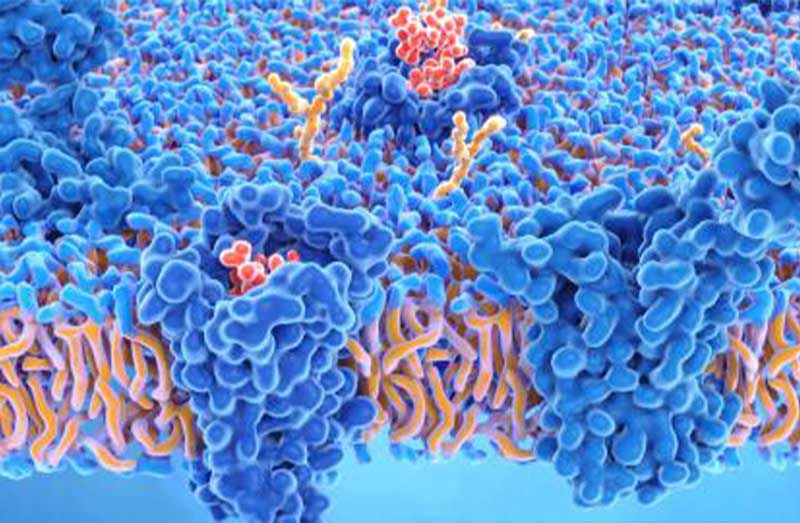
How do endocannabinoids break down?
His life in the body is very short. Once they have carried out their function it is enzymes that are responsible for their decomposition:
- The hydrolasse that breaks down the AEA
- The monoaciglycerol that breaks down 2-AG
Endocannabinoid levels are determined by the balance of the synthesis and breakdown of these so most treatments that seek to level endocannabinoids in the body attack one of these two processes.

How to maintain the health of our endocannabinoid system?
A lack of exercise, overweight and stress can negatively affect the balance of our endocannabinoid system and, therefore, the homeostasis of our body. To restore balance in our body we can benefit from exogenous cannabinoids, those that are not produced by our body. More than 100 cannabinoids are found in the cannabis plant alone, although most are pending scientific study. The cannabinoids of which we already know a little more thanks to science are CBD and THC. CBD and THC interact differently with cannabinoid receptors and that’s why CBD lacks psychotropic effects. In return, CBD connects to other molecular targets such as receptors, enzymes and ion channels.
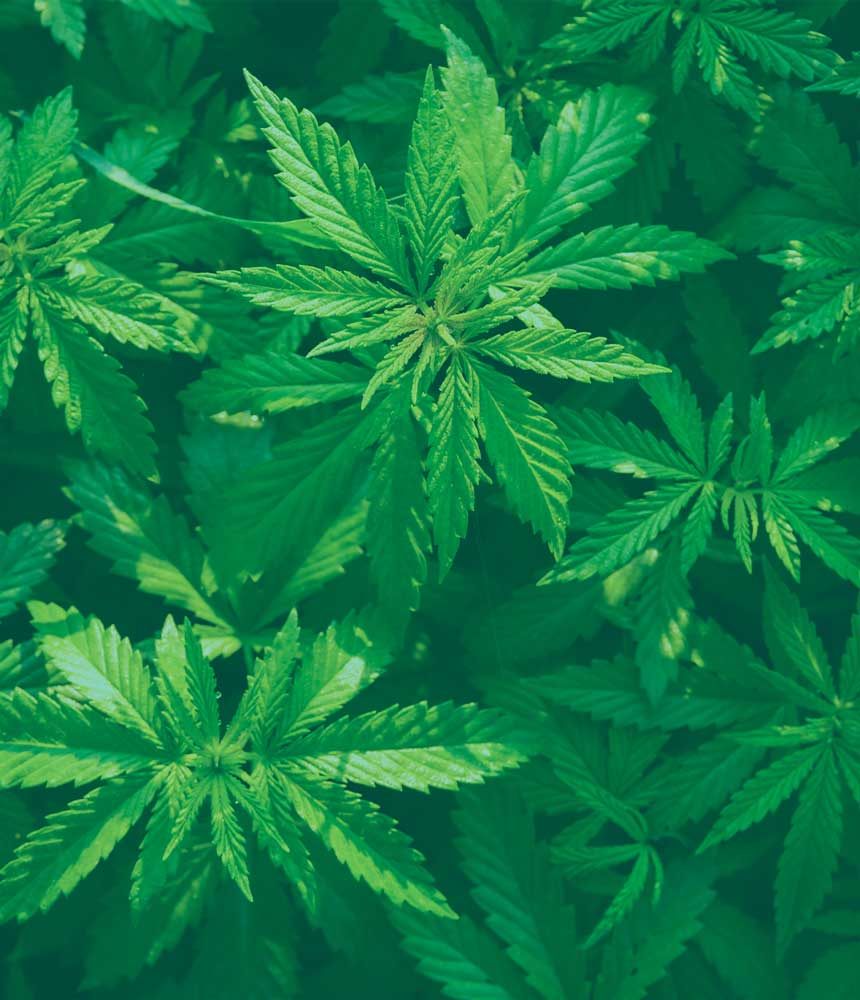
How does THC interact with cannabinoid receptors?
THC is well known to be one of the main cannabinoids found in cannabis. When tetrahydrocannabinol (THC) enters our body, it interacts directly with the endocannabinoid system, because it binds to cannabinoid receptors in the same way as endocannabinoids.
Its potent effect is due in part to the fact that it can bind to the cannabinoid receptors cb1 and cb2. As a result, THC can generate a wide variety of effects on our body and mind, some not so desirable. That is, while on the one hand it can help us to reduce pain and stimulate appetite, on the other hand it can cause anxiety, and in some cases paranoia.
Because of this, scientists are now looking for ways to produce synthetic THC cannabinoids that interact with the endocannabinoid system, but only in a health-positive way.
And while the endocannabinoid system plays an important role in keeping the body’s internal processes stable, much research is still needed to better understand its functions and potential benefits.

How does CBD affect our endocannabinoid system?
If you want to know more about the benefits of CBD consumption we recommend that you read our related article.
Related articles
CBD and contraceptives
CBD and contraceptives. We explain what they are, and which are the most common pregnancy prevention methods Enter!
Tantric exercises to improve your sexuality
Tantra is a complex and ancient practice with a wide range of techniques. Can be used to enhance sexual experiences
Gifts for people with anxiety
When it comes to selecting gifts for people with anxiety, it is important to keep in mind that everyone's experiences and coping mechanisms are different. However, in this article we share with you some gift ideas that can be beneficial for people with anxiety.What...
CBD for studying
Did you know that you can use CBD to study and improve your academic performance? Enter to find out how CBD helps you study better!
Is CBD oil safe during pregnancy and breastfeeding?
Pregnancy and breastfeeding are very delicate times for the health of mother and baby, so many substances are not compatible with the process. If this is your case and you are not sure about the effects that CBD oil can have on your body, you should know this...
What is Bisabolol, and what are its benefits?
Bisabolol, a cannabinoid that despite being little known, is known to have enormous medicinal potential Enter now!
Subscribe to our newsletter
Subscribe and receive a 10% discount on your purchase.
Store
Categories
Guides
Legal notice and privacy policy



